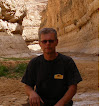Day 429
49,659 km since the beginning of the journey
Current Location: Namibia, Windhoek
I am leaving Sesriem as the red sandy hills of Namibia have been looked over during two unique moments : at sunrise and at sunset. And at two o`clock it is too early to consider to stay here for one more day. Before leaving I visit a gas station. Namibia is sparsely populated and that's why I use every opportunity to refuel. Could also be less frequent, there has been now some sort of refueling opportunity every 100-200 kilometers. Basically, the bus usually can run on the fuel with up to 1,500 km without refueling, but still more secure to have enough proper fuel. About diesel quality - interestingly, the fuel here seems to be of better quality than in some other countries.
There is a cafe at the gas–station. The tables are outdoors and there is a motorcycle with Australian license plate. Too rare meeting to move on without changing information. We talked at least for a couple of hours.
I drive on northwards, look at the map and notice a familiar name, Solitaire.

I make a stop, here's a gas station, auto repair shops, small coffee shops. And here too the vehicles of the last century are used to design the place.





Cafeteria table.


Some captures of earlier days.
Namibian wild horses.

Namibian wild horses live in the desert, the area is about 350 square kilometers. Their exact origin is still unknown, according to locals they have been here since the "German years".
One legend says they are from a horse-breeding farm that had belonged to the German nobleman, Baron Hans Heinrich von Wolf. The baron built here the famous castle known by the name "Castle Duwisib". After his death in the World War 1 the animals ran off.
According to another legend, they were German army horses, also from the beginning of the last century, and they had run off when in 1915 a military camp was bombed by aircraft.
And there is another legend according to which they had come from a ship which was to bring horses from Europe to Australia and by the mouth of the Orange River had run on the rocks and only the strongest animals swam to the shore and reached the Garubi plains.
Spergebiet was a closed area that belonged to the CDM-Ile (Consolited Diamond Mines) and during the years from 1970 to 1980 CDM security officer saw to it that the horses would have drinking water available, and so modern water tanks were installed in Garubi for the company money.
In 1991 the first attempt was made to count the horses from the air, and the result was 276 animals. During next years the drought reduced the number of animals, and about 30 to 40 horses died. In 1992 The Ministry of Wildlife, Conservation and Tourism launched the operation to preserve and breed the horses, 104 animals were caught and sold to locals and the remaining 80 wild horses were fed, until in March 1993 it began to rain again. Nowadays the number of horses is about 150.

The protection of the horses has led to some discussion - on one hand it is alleged that they have historical and scientific value and should not be removed from the protected area. On the other hand, it is claimed that the horse is in this region is of the alien species, and they compete for the dinner table with gazelles. The real situation is such that both types drink the same water in turns and there was no sign of any special competition.
Horses are rare in the sense that they have survived in these harsh desert conditions - they have been isolated for many generations, and have become self-reliant in finding food and water.

And still some are in the habit of stepping into other`s drinking water.

Further on the road passed the Duwisib fortress that was built in 1909 by Baron Hans-Heinrich von Wolf .Very strange to see here in the desert such an unfamiliar building.

Most of the materials were brought from Germany, only the building blocks were local. Bricklayers were brought from Italy, Sweden and Ireland. The Baron himself traveled to Europe. In 1914 when the war broke out, he joined the army and died in 1916 in Somme, his wife never returned Namibia and the castle was sold at the end of the war. Currently the building belongs to the state of Namibia, the museum was opened in 1991, and a few hundred meters away is the campsite.

The Satellite dish has found a convenient place.

Further along is the dining room.

Card game table, walnut, made in Pompei.

For colder days there are 2 large fireplaces in the corners of the room. Cold means that outside at night the temperature could be close to zero.


Another small room, pictures on the wall of the great military commanders. Below in the center is Napoleon on the island of St.Helena.


Inner courtyard, green and shady.
And finally, a geographically important position, the Tropic of Capricorn or the Tropic of Capricorn.

There were no labels or signboards, no proof of life. So I made the important line myself on the ground, took a picture of it and drove on. Definitely there are signs on bigger roads, but here – nothing. Practically, this means that now the sun can be in the zenith again.



No comments:
Post a Comment